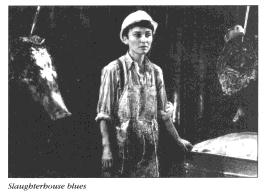 Slaughter city
Slaughter cityby Naomi Wallace
Reviews, Socialist Review, No.195, March 1996.
Copyright © Socialist Review.
Copied with thanks from the Socialist Review Archive at http://www.lpi.org.uk.
Marked up by Einde O’Callaghan for the Marxists’ Internet Archive.
 Slaughter city
Slaughter city
by Naomi Wallace
There are very few plays which depict the reality of life in factories. And there are fewer still as powerful as this one.
Unfortunately, however, that is not the main reason it has been much praised by the review pages of most of the posh papers.
The author was moved to write the play after her experiences on the picket line of workers in a big meat company and it is set in a midwest slaughterhouse. The main characters work there, their bodies scarred from the knives used to slash cattle carcasses, the sensation in their hands destroyed by vibrating machinery, their backs aching from incessant lifting and reaching, their sex lives ruined by physical strain and mental stress.
They have just lost a strike for a new contract, and now the only way any of them can see of improving their position is by punishing their bodies and minds still further in the search for promotion to a higher – and more dangerous-grade.
In the meantime, they engage in horseplay and banter, give vent to their sexual hangups, tell of the big and small oppressions that have led them to this hell hole. But even this may not be left to them for much longer. In the background their manager discusses whether to sack them or to make them work still harder so as to keep the firm ahead of its competitors.
Up to this point the play is realism in the best sense of the word – it attempts to tell what life is really like for the great majority of people in modern industrial societies in a way that is anathema to the ‘modernising’ political leaders, ‘new realist’ trade union leaders and ‘postmodernist’ theorists alike. But it attempts to do more than this – to show the historical continuity of working class experience and class struggle.
The author does this by introducing two ghostly characters – a new worker who, after getting a job by pretending to be a scab, is soon reciting from the Communist Manifesto, and a middle class man who purports to be the inventor of the first sausage machine. It transpires they have both been around before, recalling conflicts between bosses and workers of decades or even a century ago. They tell how they act out episode after episode of class struggle as they wander through history tied in permanent antagonism to each other, neither able to dispense with the other.
Unfortunately, however, it is not these strengths but certain weaknesses in the play that seem to have appealed to the critics.
Firstly, the symbolism in the play gets out of hand at points, verging on a mysticism that distracts you from the action as you wonder what it is all about. Secondly, and connected with this, there is an attempt to integrate certain feminist themes in a way that obfuscates rather than clarifies. And finally, the overall conclusion is that the class struggle always ends in disaster.
At one point, the ‘worker ghost’ complains to the ‘boss ghost’ about this. ‘Can’t we just once scratch a way through to a different world?’ But the message of the play seems to be, ‘No.’
All history may be the history of class struggle but the result is ‘the mutual destruction of the contending classes’. Still, there are not many plays that even hint at any of the issues this one deals with, and that makes it well worth seeing.
Slaughter City plays at the Barbican, London
Last updated on 21 December 2009